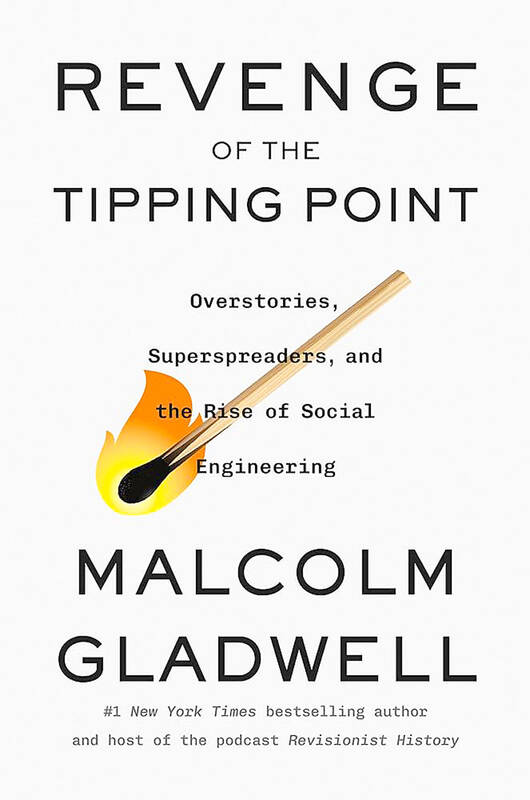It’s almost 25 years since Malcolm Gladwell published The Tipping Point, which sought to understand social phenomena — the drop in crime in New York or the sudden popularity of Hush Puppies shoes — from an epidemiological perspective. Its main thesis was that cultural changes don’t take place as a matter of steady gradualism but instead reach a critical mass that opens the flood gates or enables a trend or product to “go viral.”
The book, his first, itself acted like an infectious virus, as it went on to sell millions around the world. It also helped create a new genre, which mixed science and business and popular culture with counterintuitive theories, a formula repeated by books such as Freakonomics and host of other imitators, and one more or less reused by Gladwell himself in a further six bestselling books.
Now he has returned to that first trendsetter with Revenge of the Tipping Point. Apparently, his initial intention was simply to update the first book, but in the process he realized that he wanted to write a completely new work. The result is an odd and occasionally frustrating confection that takes the (sometimes disputed) conclusions of the original as a given, and then sets off on a self-consciously digressive examination of Miami’s corruption problem, a suicide outbreak at an elite school and the struggle for same-sex marriage, among several other seemingly unrelated subjects.

What was once novel and bracing has hardened over the years into a structural cliche, a storytelling tease designed not just to defer intellectual satisfaction, but to suggest a join-the-dots hidden narrative that will eventually cohere into a revelatory unifying theme. That moment never quite arrives. Along the way there are plenty of interesting facts and thought-provoking ideas but Gladwell introduces them with prose that has evolved (or devolved) from a variation of the middle-highbrow New Yorker house style into something much more folksy and podcast-like. His sentences are littered with phrases such as “Oh my” and “Are you kidding me?” and “You guessed it,” as though his readers are looking for conspiratorial bonhomie, as though, in other words, they are fans.
None of that would matter very much if the book held together as a well-argued thesis, but if it has something new to say beyond what was written a quarter of a century ago, then it’s never made entirely clear. It starts out with a political hearing in which the identities of the participants are concealed, but which obviously concerns Purdue Pharma, the company that triggered the opioid crisis in the US. Sure enough, Gladwell reveals what we already knew in a final chapter that rehashes this well-covered story.
The point he’s seeking to make in the intervening 300 pages is that epidemics — whether opioid, COVID, white flight, or any other kind — all have causes and rules and therefore appropriate measures can be taken. It’s just that he takes an awfully roundabout way of getting there; so roundabout, in fact, that this reader often lost his way. Gladwell seems alive to this danger because he keeps having to summarize “what we’ve learned so far,” and then open sections with sentences such as: “So: Back to the LA survivors club… in the late 1950s.”
That particular switchback concerns the plight of Holocaust survivors relocated to California, and how for three decades after the war they kept their horrific stories to themselves. What changed everything, argues Gladwell, is an American TV miniseries in 1978 called Holocaust that suddenly enabled public discussion of the Nazi genocide three decades before. There’s certainly good evidence that the drama popularized the word “Holocaust,” which helped define the horror and allow it to be discussed. For Gladwell, this meant it changed what he calls the “overstory,” the meta-narrative in which all epidemics — good and bad — unfold.
It’s one of a number of less-than-scientific terms that Gladwell employs as though they were established paradigms. He refers elsewhere in the book to the “Magic Third,” the fraction of a group that is required to effect change, as a “universal law. (Or at least something very close to universal.)” One example he gives is that in a boardroom of nine directors, two women is not a sufficient number to empower effective function in a male-dominated environment. Yet studies show that the addition of a third woman — making a (magic) third of the directors — does lead to female flourishing at board level. What does that mean for minorities? Does every minority need a third of representation in the boardroom to attain best performance? In any case, there is also, Gladwell acknowledges, a Magic Quarter, in which 25 percent is the tipping point for other group dynamics.
And if this universal law is starting to look a bit slippery, then let’s consider the role of superspreaders (in both pathological and cultural epidemics), whom Gladwell discusses at length in a fascinating section on aerosol science. In a British study of 36 people with COVID it was found that 86 percent of all COVID virus particles detected in the group came from just two people. Gladwell calls this the “Law of the Very, Very, Very Few” (in a winking reference to the Law of the Few he outlined in the first book). Exactly how this law is reconciled with the near universal Magic Third or even Magic Quarter is not, as far as I can see, explained. Could it be that different epidemics with different factors behave in different ways?
As there’s some limited evidence to suggest that respiratory virus superspreaders tend to be older and obese, Gladwell asks what actions we would take if this turns out to be true. But despite the “social engineering” in his subtitle, he discreetly concludes: “We will have to decide how far we are willing to go in order to save lives.”
At the end of the book Gladwell reaffirms that epidemics have comprehensible rules and we have the tools to deal with them. The moral issues stemming from how these tools might be utilized remain conspicuously unaddressed.

Climate change, political headwinds and diverging market dynamics around the world have pushed coffee prices to fresh records, jacking up the cost of your everyday brew or a barista’s signature macchiato. While the current hot streak may calm down in the coming months, experts and industry insiders expect volatility will remain the watchword, giving little visibility for producers — two-thirds of whom farm parcels of less than one hectare. METEORIC RISE The price of arabica beans listed in New York surged by 90 percent last year, smashing on Dec. 10 a record dating from 1977 — US$3.48 per pound. Robusta prices have

A few years ago, getting a visa to visit China was a “ball ache,” says Kate Murray. The Australian was going for a four-day trade show, but the visa required a formal invitation from the organizers and what felt like “a thousand forms.” “They wanted so many details about your life and personal life,” she tells the Guardian. “The paperwork was bonkers.” But were she to go back again now, Murray could just jump on the plane. Australians are among citizens of almost 40 countries for which China now waives visas for business, tourism or family visits for up to four weeks. It’s

The resignation of Taiwan People’s Party (TPP) co-founder Ko Wen-je (柯文哲) as party chair on Jan. 1 has led to an interesting battle between two leading party figures, Huang Kuo-chang (黃國昌) and Tsai Pi-ru (蔡壁如). For years the party has been a one-man show, but with Ko being held incommunicado while on trial for corruption, the new chair’s leadership could be make or break for the young party. Not only are the two very different in style, their backgrounds are very different. Tsai is a co-founder of the TPP and has been with Ko from the very beginning. Huang has

Beyonce on Sunday finally won the Grammy for the year’s best album for her culture-shaking Cowboy Carter, as rapper Kendrick Lamar posted a clean sweep on a night that served as a love letter to fire-ravaged Los Angeles. Chappell Roan, Charli XCX, Doechii and Sabrina Carpenter emerged as big winners at the performance-heavy gala, while heavyweights Taylor Swift and Billie Eilish went home empty-handed. Beyonce’s win for Cowboy Carter now makes her the most nominated, most decorated artist at the awards show ever — as well as the first Black woman to claim the top prize in this century. The triumph was all